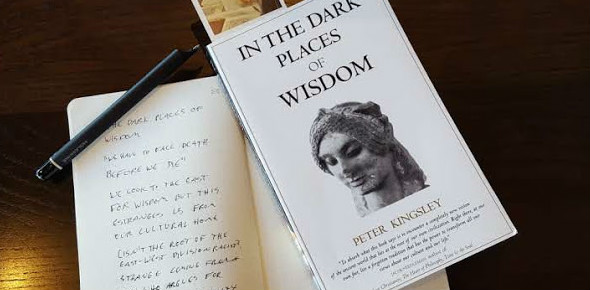
Peter Kingsley’s book In the Dark Places of Wisdom is a story. It’s a scholarly work making a serious point but Kingsley sweeps away the academic apparatus and banishes notes to the end of the book. He writes in a strikingly simplistic style. It’s a conversational narrative, parceling out information in small bits and retracing ideas. It focuses on Parmenides and his visionary poem “On Nature”. Kingsley describes the poem’s style as incantory, invoking a trance state. Through his stylistic choices it seems this is also what Kingsley means his own book to do.
The story challenges scholastic traditions which center civilization on Athens. This is a guiding theme for Kingsley and an important point. I think in the case of this book it’s a bit of a distraction – it points back at the rational mind which the prose is working to bypass. Parmenides’ insights are interesting enough on their own.
Velia vs. Plato
Phocaea was a Greek city on the coast of Anatolia. In the sixth century BCE the Phocaeans sailed to Italy and founded the city of Elea, now called Velia. Ongoing excavations at the site of Velia throw some light on Parmenides, born there in 501, and his successor Zeno who was a decade younger.
Zeno famously preferred Velia to Athens. Parmenides and Zeno travelled to Athens as Velian ambassadors. Kingsley indicates that Zeno died running weapons to opponents of Athens. Athens won the war and the Athenian versions of history have swamped the stories of Velia.
The Athenian philosopher Plato joked that Xenophanes was Parmenides’ teacher. Plato’s successor Aristotle took the joke as fact and passed it on. Diogenes Laertius in “Lives of the Philosophers” says this isn’t true, Parmenides learned from Ameinias, a Pythagorean. Parmenides built Ameinias a hero shrine on his death.
Plato joked about killing Parmenides. Kingsley argues that Plato’s dialogue Parmenides slanders the philosopher to discredit him, a virtual killing. By killing Parmenides Plato created the west we inhabit today, one in which mind is estranged from body and philosophy is not wisdom but argument. Plato sought light in light and rejected the descent into darkness, leaving a spiritual hollow.
Priest and healer
Kingsley argues that Parmenides was an ouliades and Iatromantis, healer-priest of Apollo, and a physikos, a philosopher-healer. He founded a line of healers, adopting Zeno as his son and successor in an initiatory rite.
When Pythagoras left Samos for Italy he took Anatolian traditions with him, including the incubation chamber. Kingsley says the Pythagorean healers of southern Italy guided through incubation. In temples patients were placed in dark chambers to be healed through dreaming. The healers themselves underwent incubation. In this incubation patients and priests descended into the dark underworld. Kingsley describes this as a shamanic practice. He says, “Objects and inscriptions have also been found that show a continuity of shamanic tradition stretching all the way from the boundaries of Greece across Asia to the Himalayas and Tibet, Nepal and India.”
Apollo himself was originally a god of incubation. He became a sun god in Anatolia about the time of Parmenides. This revelation was described in esoteric terms as if it was an initiatory secret.
Through incubation Pythagoreans reached stillness, hesychia. Parmenides learned this practice from Ameinias.
Orpheus
Kingsley draws parallels between Parmenides and Orpheus, also a priest of Apollo. An early poem fragment has Orpheus staying near a volcano (light in depths) in an incubation chamber, casting his descent into the underworld as a healing dream. Orpheus used Apollo’s magic incantations to visit queen of Dead.
Kingsley says “For centuries people have been upset with Parmenides because he wrote a poem.” Philosophers are supposed to speak in the clear. Kingsley himself admires the quality of the poetry. Repeated words have an incantory effect. Repetition, Kingsley says, is the voice of our spiritual longing.
Kingsley says Parmenides’ insight was that Apollo shares his oracle with Night. The sleep of incubation is healing; the touch of the goddess of death can also heal. Priests of Apollo are priests of Persephone.
On Nature as initiation
Kingsley interprets Parmenides’ poem as a description of a visionary descent into the underworld. Parmenides travels with the daughters of the sun to the place where the sun lives – that is, the underworld, where the sun emerges each day and retreats each night. He passes through a gate guarded by Justice. He is welcomed by the goddess who greets him kindly, offering her right hand. Kingsley places Parmenides in the context of his place and time. Vases from southern Italy portray three figures: a hero, often Heracles; the guide, Justice; and Persephone reaching her right hand to the hero in welcome. On Nature describes that image. Kingsley argues that Parmenides’ goddess is Persephone.
The goddess tells Parmenides that he is not yet dead. This descent is a dying-in-life, an initiation. Parmenides is a kouros, which here does not mean young man but initiate. The goddess is kourotrophos, the nurse of the young and guide to initiates. The journey describes Pythagorean opposites: male-female, light-dark, heaven-earth, day-night. Wherever Parmenides journeys he sees goddesses, he travels in the female world of darkness.
The snake and the sun
The sound that draws Parmenides on his journey is the sound made by a syrinx, a wind instrument that makes a hissing sound, like a snake. Parmenides describes the gate which opens for him as spinning in hollow tubes or “pipes”. These pipes are also described in the Mithras Liturgy where they lead the magician to the sun. The Mithras Liturgy instructs the magician to hiss like a snake, making the noise of the pipe.
Apollo is associated with snakes. When he kills snake at Delphi he buries her under the ground, Kingsley says to absorb and appropriate her oracular power. Apollo’s son Asclepius the healer appeared in a hissing of snakes. (I know from other reading that snakes were used by Asclepian priests in incubation chambers). A play enacted at Delphi portrayed the young Apollo, the kouros/initiate, as killing the snake. The play ended with the playing of the syrinx, making the sound of the snake which was also the sound of the sun.
The lawgiver – healer
The Sicilian poet Empedocles passed on the tradition that the four vocations closest to divine are prophet, poet, healer and lawgiver. Kingsley argues that we need to understand Parmenides as a lawgiver like those Plato described in the Republic. The Iatromantis (healer) is a lawgiver because “to give good laws to a city is to heal it.” Justice is healing.
Kingsley says that philosopher initiates are lawgivers, “not just any kind of lawgiver but lawgivers who are prophets, who’ve received their laws from another world.” (That gives me pause – we hear the same argument from Christian fundamentalists that their laws come from another world, which never turns out well for women.)
The male journey
I note that Kingsley describes the priest, initiate, prophet, philosopher, lawgiver all as male. He calls the recipient of the Mithras Liturgy the “son” of the teacher even though the script itself addresses the daughter. He mentions in passing that women were in charge of Demeter-Persephone temples but did not write (or their writings did not survive) so we know about them only from the archaeological record.
Kingsley points out that Apollo becomes a lawgiver through killing the snake and appropriating her oracular power. We know that Zeus becomes a lawgiver through eating the goddess of wisdom, Metis. I’m weary of male initiates turning into male lawgivers through appropriating women’s knowledge and power. Where is the Justice in that?
Input into my work
Kingsley points to the Pythagorean tradition which was eclipsed by the Platonic. This is an important and necessary work. It is also firmly in the tradition which casts the male youth as journeyer/initiate and the female companions as aids to the male journey. As a woman initiate undertaking my own journey I am not included in that portrait. My calling is not to embody the goddess so a man can realize his work, it is to realize my own work as a woman magician without having to imagine myself as a man to do it.
As a next step we can unearth the Pythia, bring Metis back to the light of day, and restore the woman as lawgiver. Our times seem especially to call for this. Persephone in the underworld calls to mind an earlier goddess Ereshkigal. In the oldest story it was a goddess, Inanna, who journeyed to the underworld. The Pagan Book of Living and Dying explores myths of descent as healing stories.
Kingsley’s work is an important first step toward restoring the healing power of darkness. The full restoration lies in recasting the journey not as a male journey but a human one.
Quotes
p. 6: “…if we want to grow up, become true men and women, we have to face death before we die.”
p. 9: “…even our tomorrows are the past acting itself out.”
P. 96: “…death is the place where all words come from…”
p. 164: “There were early philosophers – and Parmenides was one of them – who were quite specific about one point. This is the fact that everything is alive and death is just a name for something we don’t understand.”



